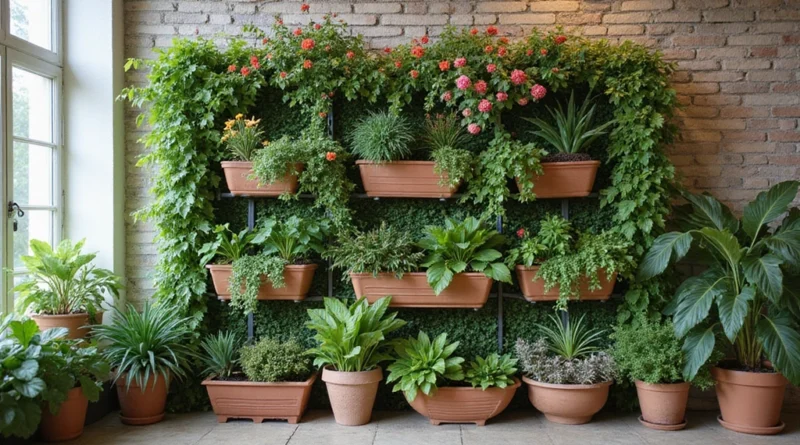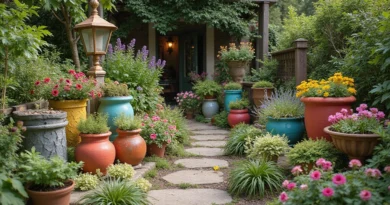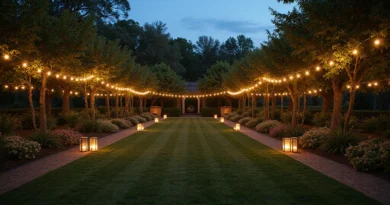How to Maximize Your Space: Create a Gorgeous Vertical Garden in Any Home
Bringing greenery into your home doesn’t have to mean sacrificing precious floor space.
With a little creativity and some clever planning, vertical gardens can transform any blank wall or small nook into a lush oasis.
Whether you have a tiny apartment or a spacious house, vertical gardening is a stylish and space-saving way to enjoy nature indoors. From herbs in the kitchen to beautiful blooms in the living room, the possibilities are endless! Let’s explore some fantastic ideas to help you create your own vertical garden that will make your home feel vibrant and alive.
1. Choose the Right Location

Finding the perfect spot for your vertical garden can make all the difference. Look for areas that receive ample natural light, as most plants thrive under sunshine.
Consider placing your garden near windows, patios, or even in a well-lit hallway. Ensure the wall can support your garden’s weight and is easily accessible for watering and maintenance. A good tip is to select a place where you can enjoy looking at your garden daily; this will keep your motivation high. Additionally, think about the climate of your location and choose plants that will flourish within that environment.
for Choosing the Location:
– Assess the light conditions throughout the day.
– Make sure it’s easy to reach for watering and pruning.
– Think about how the garden will look and feel from various angles.
A well-chosen spot can lead to a thriving vertical garden that enhances your space beautifully.
2. Start Small with Succulents

If you’re new to vertical gardening, starting with succulents is a fantastic idea. They are low-maintenance, come in various shapes and colors, and can thrive in small spaces.
You can create a stunning succulent wall by using shallow frames or hanging pots. They require minimal watering, making them ideal for beginners. Arrange them creatively to create patterns, or mix different varieties for a vibrant look. The great part is that they can grow in less light compared to other plants, making them perfect for indoor gardens.
Ideas for Succulent Arrangements:
– Use repurposed wooden pallets as a vertical planter.
– Create a succulent collage in shadow boxes.
– Hang individual pots in a staggered pattern for depth.
Starting small with succulents can lead to a delightful and manageable vertical garden experience.
3. Use Vertical Planters and Wall Grids

Vertical planters and wall grids are perfect tools for maximizing your space. These structures allow you to grow a larger number of plants in a small area while adding a unique design element to your home.
You can find a variety of vertical planters made from materials like wood, metal, or fabric, each bringing its own style. Wall grids can hold pots or vases and can be rearranged as your garden grows. This flexibility allows you to experiment with different arrangements and plant selections over time. Moreover, these planters can be filled with everything from herbs and flowers to trailing vines, giving you an ever-changing display.
Benefits of Using Vertical Planters:
– Saves floor space while maximizing plant coverage.
– Easy access for watering and harvesting.
– Ideal for both indoor and outdoor spaces.
Incorporating vertical planters can elevate your interior décor while providing a lush, green focal point.
4. Create an Herb Garden in the Kitchen

Imagine having fresh herbs at your fingertips while cooking! A vertical herb garden in your kitchen not only saves space but also enhances your culinary experience.
You can use wall-mounted planters or hanging pots to grow herbs like basil, parsley, and rosemary. They require minimal space and are available in many forms, like small jars or pocketed fabric planters. This setup is not just functional; it adds a delightful green touch to your kitchen décor. Moreover, having fresh herbs on hand can inspire you to cook more meals at home, adding flavor and nutrition.
for an Indoor Herb Garden:
– Choose a sunny spot, ideally near a window.
– Use containers with good drainage.
– Regularly trim your herbs to promote growth.
Creating an herb garden can transform your cooking space and elevate your meals.
5. Incorporate Vertical Gardening into Your Balcony

If you have a balcony, this space can quickly become a lush retreat with vertical gardening. Installing wall planters or trellises can help you maximize your growing area while allowing you to enjoy the outdoors.
Choose climbing plants like peas or flowering vines to create a stunning view as they grow up your walls. This not only adds beauty but also provides privacy if you’re in a densely populated area. Additionally, you can combine different types of plants to create a mini ecosystem, attracting butterflies and hummingbirds to your space.
Balcony Vertical Gardening Tips:
– Ensure your plants receive adequate sunlight.
– Use lightweight containers to avoid straining the railing.
– Mix edible plants with ornamental ones for a diverse garden.
With a little creativity, your balcony can be transformed into a vibrant sanctuary.
6. Consider Using Recycled Materials

One of the most charming aspects of vertical gardening is that you can use recycled materials to create functional and aesthetic planters. Think outside the box—old wooden pallets, plastic bottles, and tin cans can be repurposed into amazing vertical gardens.
Not only is this an eco-friendly option, but it also adds a unique character to your space. You can paint or decorate your recycled planters to match your home’s style or let them take on a natural, rustic look. This creativity not only saves money but also helps reduce waste.
Ideas for Recycling:
– Cut plastic bottles in half and hang them to grow herbs.
– Use old crates to create tiered plant displays.
– Fashion tin cans into fun hanging planters.
Recycling materials for your garden makes it a personalized project that’s both sustainable and stylish.
7. Explore Hydroponic Vertical Gardens

Hydroponic vertical gardens are an innovative way to grow plants using water and nutrients instead of soil, making them perfect for indoor gardening. They’re efficient, space-saving, and can produce faster growth rates.
In hydroponics, plants are suspended in nutrient-rich water, and it’s a clean method that minimizes mess and pests. Vertical hydroponic systems can be set up on walls or even as freestanding towers. You can grow a variety of plants, from leafy greens to strawberries, and the setup often adds a modern touch to your home.
Hydroponic Gardening Tips:
– Research which plants thrive best in hydroponic systems.
– Regularly check the pH levels of your nutrient solution.
– Ensure proper lighting for optimal growth.
Exploring hydroponics can elevate your gardening experience, offering convenience and impressive results.
8. Layer Plants for Depth and Interest

Layering your plants in a vertical garden creates visual interest and depth, making your garden look more dynamic. Mix taller plants with shorter ones to create a cascading effect.
This method not only enhances the aesthetic but also ensures that all your plants receive adequate sunlight. When selecting plants to layer, consider varying textures and colors. For instance, pairing soft, trailing vines with bold, upright plants can add an exciting contrast. Additionally, you can mix edible plants with ornamental ones for a garden that’s both beautiful and functional.
Layering Tips:
– Use taller plants in the back and shorter ones in the front.
– Incorporate plants with different leaf shapes for contrast.
– Choose a mix of flowering and foliage plants for year-round interest.
Layering plants can significantly elevate your vertical garden game, creating a stunning focal point in any room.
9. Choose Easy-to-Care-For Plants

When starting your vertical garden, it’s crucial to select plants that suit your skill level and lifestyle. Easy-to-care-for plants will help you maintain the garden without feeling overwhelmed.
Consider plants like pothos, ferns, or spider plants, which are resilient and adapt well to indoor conditions. You can also choose herbs and small vegetables that not only flourish in a vertical setup but also provide fresh ingredients for your kitchen. By starting with low-maintenance plants, you can build your confidence and enjoy the rewards of gardening.
Beginner-Friendly Plant Options:
– Pothos: Thrives in low light and requires infrequent watering.
– Snake Plant: Very forgiving and can tolerate neglect.
– Herbs: Basil, mint, and chives are excellent choices for beginners.
Selecting easy-care plants will allow you to enjoy the joys of gardening without the stress.
10. Regular Maintenance is Key

Lastly, don’t forget that regular maintenance is essential for a thriving vertical garden. Set aside time each week to check your plants, ensuring they are healthy and happy.
Watering schedules will vary depending on the plants you choose; some may need frequent watering while others prefer to dry out between drinks. Regular pruning helps to encourage growth and keeps your garden looking neat. It’s also a great opportunity to remove any dead or yellowing leaves. By staying on top of maintenance, you can enjoy a gorgeous vertical garden that continues to thrive and beautify your space.
Maintenance Tips:
– Create a watering schedule based on plant needs.
– Regularly check for pests and signs of distress.
– Prune and reshape plants as necessary to promote healthy growth.
With proper care, your vertical garden can flourish, providing beauty and freshness to your home.
Conclusion

Creating a vertical garden can be a rewarding journey that enhances your living space while bringing nature indoors.
With the right planning, a touch of creativity, and consistent care, your vertical garden can thrive and provide joy for years to come. Explore the ideas shared and consider which elements resonate with your style and space—every step you take toward green living is a step toward a more beautiful home.



